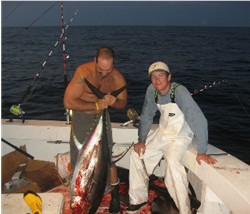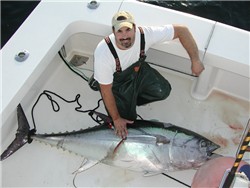Tuna Chunking
Well, the offshore tuna chunking season is beginning. I’ll cover the basics.
My trips start days in advance, when I and my crew begin studying temp charts and gathering as much data as possible from other captains as to where to set off for the trip.
I use a couple of free, online chart services from Rutgers University and Hot Spots and also order a chart from Roffs to locate the best water that should be holding fish.
But as I said before we try to get recent reports from boats that sailed and had good catches.
Preparation
We start by getting the freshest baits possible. Make sure you look at the eyes and fins on the butterfish and sardines. The eyes should be clear, and the fins shouldn’t be all withered or beat up.
We typically get three to five flats of butterfish and one or two flats of sardines and buy a bunch of packages of frozen squid from the supermarket.
All the bait is cut or chunked at the dock before the trip, and all of it is mixed together in garbage bags and stored on ice below deck.
When cutting the chunks we’re on the lookout for large, fresh sardines and butterfish. These are put on ice in zip-lock bags and used as hook baits.
Rigging Up
We use Shimano Tallus 60- to 80-pound-class rods mated to Shimano 50-wide reels spooled with 80-pound Momoi monofilament line. We also use Tallus 20- to 40-pound-class rods with Shimano Tyrnos 2-speed 30 reels with 40-pound mono.
We use 5/0 Gamakatsu 4X octopus circle hooks tied to Gamma 40-, 50-, 60- and 80-pound fluorocarbon leaders attached to the main line with Spro 130-pound swivels.
Three rods are rigged with black fish-finder sinker slides with snaps on them, so we can use whatever weight we need to get the baits down to where we want.
All of our knots are Palomars because they have approximately 100-percent knot strength, and we can tie them easily in the dark.
 |
Twelve to eighteen rigs of each size leader are made up ahead of time, so we aren’t wasting time retying rigs from scratch when we get into fish.
Make sure your harnesses and belts are adjusted and ready to go. Also make sure your gaffs are sharp and ready to go.
Setting Up
We start throwing chunks as soon as we arrive. A handful is thrown out to see what type of drift there is or which way the chunks will go as we set our anchor or adjust our position for the drift.
We’d rather drift if we can stay with the water or the marked fish and bait.
Once you’re set up, make sure everyone has a job to do. One angler will throw chunks consistently: three to five chunks every 50 to 70 seconds. If the chunker has to go away from the bucket, make sure someone takes over. This is very important, because you never want to break the slick.
We keep a chum chucker on the boat so we don’t have to worry about hand-ladling the chunks and just have to make sure that the hopper is full at all times.
Start off with 60-pound leaders, and go to 40-pound if the fish are line shy. If the fish are big and hitting hard, go up to 80-pound leaders.
We cut a butterfish in half and run the hook through the mouth and out the gill. Then the hook is inserted back into the bait under the pectoral fins, with just the point protruding. Cut off the fins so the bait doesn’t spin. The sardines can be hooked in a similar fashion but are better off hooked through the eyes. To fish the baits, we place them the following ways: one above the thermocline around 80 or 90 feet down, and one just below it, usually 100 to 120 feet down, and one about 50 feet. We also use one as a “floater” that is hand-lined out without weight, back in the slick 100 feet or more, and then reeled in and repeated.
 |
Once the squid arrive around the boat we’ll do our best to either scoop them up with a net or jig them with squid jigs if they’re deep. We’ll take the live squid, hook them in the mantle and drop them right back down, staggered the same way as the butterfish and sardines.
Make sure there are more rods rigged and ready to go. When the bite is on it may last only 30 minutes or 3 to 4 hours. In any event you want to make sure you’re spending the most amount of time with baits in the water, as opposed to re-rigging rods and tying rigs when the bite is hot. These are the basics. A good way to learn, and to hook up, is to fish with someone who’s experienced or a pro. Good luck!
